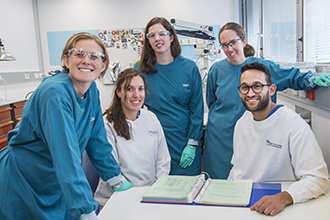New immune defenders added to blood cell

Our researchers have revealed the identities of new subsets of immune cells at the frontline of our body's defenses against infection.
The research team's discovery expands the understanding of immune cells called granulocytes – immune cells that can trigger inflammation and engulf microbes to slow an infection's progress. As well as protecting against infection, granulocytes contribute to inflammatory conditions such as asthma and allergy.
The research, led by Walter and Eliza Hall Institute researchers Dr. Carolyn de Graaf, Dr. Kirsten Fairfax and Dr. Jessica Bolden, extends to the team's extensive 'atlas' of blood cells, called Haemopedia. The new findings were published in two articles in the Journal of Leukocyte Biology.
Distinguishing new cell types
Our immune system is a complex network of cells working together to prevent infection and keep us healthy. However, excessive or misdirected immune cell activity can drive inflammatory conditions such as asthma and allergies.
Granulocytes are critical 'front line' cells in our immune system, serving as a rapid defense against infection by engulfing invading microbes, triggering inflammation and alerting other immune cells to the threat.
The surface of granulocytes is covered with molecules that influence the cells' function, Dr. de Graaf said. "Our team focused our attention on a surface molecule called Siglec-F, which had previously been implicated in 'switching off' a type of granulocyte called eosinophils," she said.
Eosinophils are important triggers of inflammation in response to parasitic infections, but are also key players in inflammatory diseases such as asthma and allergies.
"We discovered we could divide eosinophils into two 'populations' based on how much Siglec-F they had on their surface," Dr. de Graaf said. "These two populations appeared to differ in their maturity, and thus in their function within the body. This is the first time differences in gene expression in these two populations have been documented."
Mapping cells for a global resource
The research is part of a larger project to map the expression of the body's 20,000 genes in different types of blood cells. The database of this information, Haemopedia, is freely available as a resource for the global research community.
"By comparing the genes that each eosinophil population expressed, we identified differences that further distinguished the two populations," Dr. de Graaf said.
"By making this information available to other researchers through Haemopedia, we hope it can accelerate research into eosinophils. This may help to unravel diseases linked to eosinophils such as asthma and allergies, as well as cancers of eosinophils including eosinophilic leukaemia and hypereosinophilic syndrome, a rare myeloproliferative neoplasm."
Unravelling immune cell development
The team also investigated the development of eosinophils and other related granulocytes. These cells develop in the bone marrow, originating from blood stem cells, said Dr. Fairfax.
"The developing granulocytes transition through immature stages known as progenitor cells before becoming different populations of mature granulocytes, such as eosinophils," she said.
"Using flow cytometry, we could follow the development of progenitors through different stages in the bone marrow. We discovered the amount of Siglec-F on the surface of cells varied as the cells developed. This allowed us to identify a never-before identified precursor marked by Siglec-F, which could also give rise to macrophages, another immune cell closely related to granulocytes," she said.
The discovery, which has also been documented in Haemopedia, adds extra detail to the understanding of how the many different types of immune cells develop from blood stem cells. "This discovery may also impact monitoring of patients in clinical trials targeting the Siglec family as a treatment for eosinophilic diseases," said Dr. Fairfax.
The expert technical support available at the Walter and Eliza Hall Institute was vital for the project's success. "These discoveries would not have been possible without the expertise of our bioservices staff, in particular Ms Keti Florides, Mr Merle Dayton and Ms Kim De Menezes," Dr. Fairfax said.
More information: Kirsten A. Fairfax et al. Transcriptional profiling of eosinophil subsets in interleukin-5 transgenic mice, Journal of Leukocyte Biology (2018). DOI: 10.1002/JLB.6MA1117-451R
Jessica E. Bolden et al. Identification of a Siglec-F+ granulocyte-macrophage progenitor, Journal of Leukocyte Biology (2018). DOI: 10.1002/JLB.1MA1217-475R




















